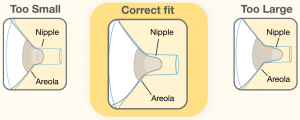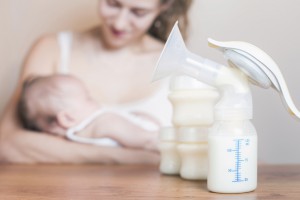After 30 hours of labor and several days of Bili beds in the NICU, Donna and her baby, Sophie, were ready to try to breastfeeding. After several days of drinking from bottles in the NICU though, Sophie wouldn’t latch. Donna visited lactation consultants several times and Sophie still wouldn’t latch.
Finally, she decided her best bet was to pump and give her baby breastmilk from a bottle for every meal. “Exclusively Pumping” (EP) was a daunting task though—Sophie was colicky and she screamed and cried all the time. Either Donna or her husband had to hold Sophie whenever she was awake, to comfort her. Donna had a hard time finding time to eat or pump… and soon her husband would go back to work and she’d have to do it all herself.
She was determined though. She pinged boards of moms and did some research. She realized she could pump with a hands-free bra, while give Sophie a bottle with one hand and eating with the other. After she figured out how to multi-task, she was self-sufficient. No. She was a rockstar.
She figured out more and more tricks to make her routine simpler, and got to a point where she could pump in the car or even pump right in front of friends, with them barely noticing what she was doing. She even enjoyed some benefits that many of her breastfeeding friends didn’t—like the option for her husband to give Sophie a bottle in the middle of the night, while she did a quick pump (then she was done and back to bed after just 15 minutes).
There are a lot of ways moms can find themselves in Donna’s shoes—if their baby spends a few days on the bottle in the NICU, if the baby has a lip or tongue tie, or if the mom experiences breast injuries—but the good news is they don’t have to stop giving breast milk if they don’t want to. Of course, Exclusive Pumping can be overwhelming, especially since many moms had never even heard of it before having a baby. And, it may seem hard to sustain with a colicky baby or even just with the constantly pumping, bottle-feeding, and washing bottle and pump parts. We’ve collected some of EP pro tips though, so if you find yourself in this situation, you’ll know that you have options and you’ll be set up for success.
- Check the size of your flanges: Pumping with flanges that are the wrong size can cause plugged ducts, which hurt and can damage your supply.

- Consider a hospital grade pump, especially if you have low/decreasing supply or plugged ducts. Breast pumps are typically less efficient at removing milk from breasts than a baby is. So your supply may decline over time, if you exclusively pump. Hospital grade pumps are way more efficient though, and may actually increase your supply over time. Consider checking your hospital, as they may offer a lower price on a pump rental than other local baby supply stores (note: they’re likely not covered by insurance, either way). Also, hospital grade pumps have a smoother (and more comfortable) suction, and some moms who get plugged ducts from pumping get fewer plugs with a hospital grade pump.
- Use a hands-free pumping bra: A hands free bra has openings over your nipples—the bra holds the bottles and flanges in place while you pump, so your hands are free (rather than having to use both hands to hold the bottles and flanges in place).
- Try giving your baby a bottle and pumping at the same time: You can prop the baby so their body is on an incline, by sitting/leaning them back against a pillow or boppy (so that the cushion supports their head and back at a comfortable angle). Then point the bottle nipple toward the baby and go for it. Assuming you’re using a hands-free bra, this still leaves your other hand completely free if you want a few minutes to eat or use your cell phone. By multi-tasking, you can avoid spending so much of your time on pumping and feeding the baby. That way you can do some other things you enjoy with your baby (or at least you’re free when the baby’s not on the bottle, to tackle your colicky baby’s needs or your other parenting challenges).
- Store pump parts in the fridge between pumps: You can go longer between washing parts, if you just rinse pump parts after pumping then stick them in a bowl or ziplock bag the fridge.
- Invest in extra pump parts and bottles: You may want to buy more than one set of pump parts and bottles, so if you’re too tired to clean them, you always have some spares available. Having extra parts will also help if you’re out and about without access to dishwashing supplies for a few hours.
- Simplify washing of parts: Some moms just keep a big mixing bowl full of warm water and dish soap by the sink. They take apart the pump parts and just toss them in to soak, when they’re dirty. Many EP moms also shared that they only fully sterilized pump parts (e.g.: boiling in a pot, or washing in the dishwasher) about once per week.
- If your hubby/significant other wants to help, let them wash pump and bottle parts: If you toss dirty pump and bottle parts into a bowl of soapy water, your significant other can pitch in by washing them (you’ll probably want a bottle brush) then placing them on a towel or drying rack. If they’re motivated to help more, have them take the night feed, while you pump (eventually you can drop this feed, but in the beginning you probably want to keep it to help your supply).
- Pump under a breastfeeding cover if you’re modest: But don’t feel like you need to bail on social plans whenever you’re due for a pump.
- Get a car adapter for your pump: You gain so much flexibility (plus the option to be away from an electrical outlet for hours at a time), if you have the option of pumping in your car. Note, you may need a different adapter if you use a hospital grade pump, so double-check compatibility closely when you buy an adapter.
- Consider giving your baby cold milk: Initially, your baby will likely take bottles cold, warm, or at room temp. Once they’re a few months old though, if you’ve been warming their bottles, they may refuse anything but a warm bottle—this can leave you with a fussy/hungry/inconsolable baby if you go somewhere where you don’t have an easy way to warm a bottle. Plus, warm bottles go “bad” much more quickly. Instead, consider giving cold bottles—first, you save time in preparing the bottle, by just taking it straight out of the fridge and not heating it. Also (more importantly), you can just put a cold bottle right back in, if they don’t finish it, rather than having to throw it out. You’ll have a lot less hassle and a lot less wasted breast milk.
- Start out emptying your breasts at least 6 times per day: If you find you have a significant over-supply you can drop to 5 times per day. If you drop to 4 or fewer pumps or feeds per day though, your supply is very likely to drop after a few days (dropping feeds is how weaning is done).
- Store milk in meal-sized portions in baggies: For example, if your baby drinks 4oz of milk per meal, store 4 oz of milk in a baggie. That way, you’ll have just the right amount available. You can lie the bag on its side in a Tupperware container, in the freezer so it will freeze flat and thin, then store it upright in a storage container (marking it with the date and how much is in there).
Donna (her whole story is true, but names are changed) ended up exclusively pumping for over a year. When she finished, she had months of frozen milk in her freezer stash. She had so much milk left over that she ended up donating hundreds of ounces to two adopted newborns who otherwise wouldn’t have gotten breast milk. Letting go of her pump after that journey was bittersweet, but she was so proud to have pulled it off and so grateful to have been able to do this for her daughter.
- – -
If you’d like to see more from Mama Lovejoy, you can follow this blog by liking Mama Lovejoy’s Facebook page. You can also subscribe to the Mama Lovejoy YouTube channel or you can find me @MamaLovejoy1 on Twitter, Instagram, Periscope or Tumblr.
